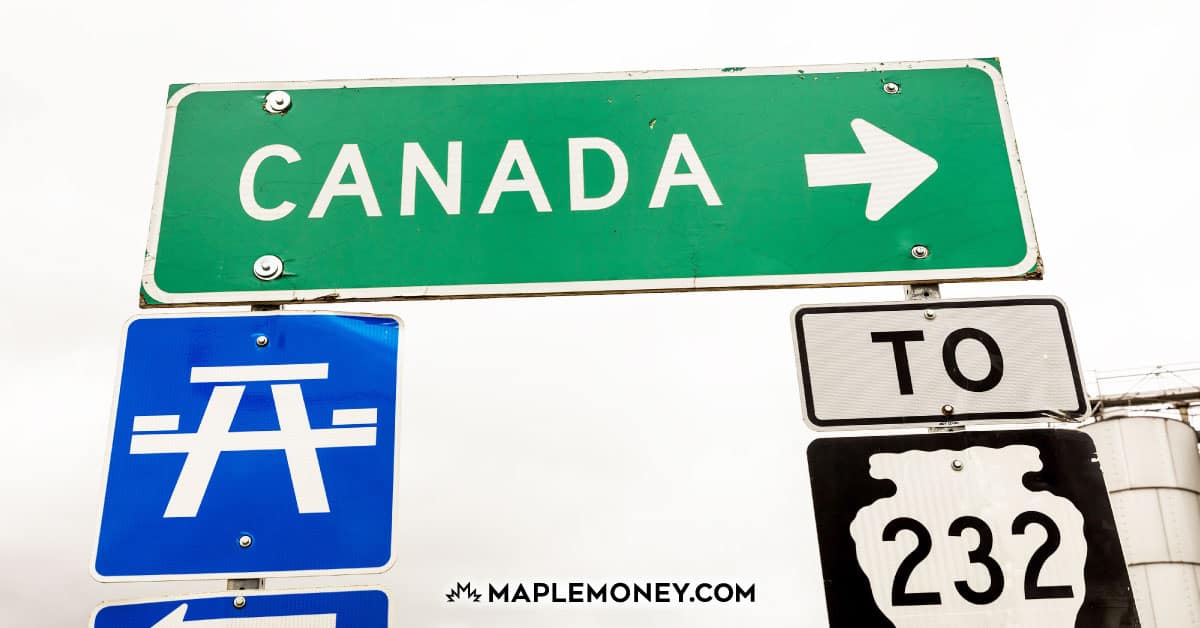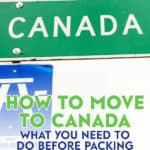How to Move to Canada: What You Need to Know Before Packing Your Bags

So you want to move to Canada, eh? Something tells me you’re not alone. It’s a topic that seems to garner plenty of attention every four years or so. But cultural and political climates aside, who wouldn’t want to move to Canada? It’s a beautiful country with a diverse society, clean cities, and wide-open spaces. Oh, and there’s universal healthcare too. That’s a big draw. But while moving to Canada is easier said than done, there are several paths you can take to the Great White North. Before exploring further, however, let’s brush up on your knowledge of this land I call home.
Some Quick and Interesting Facts about Canada
- Canada is the second-largest country by land area in the world. Only Russia is larger.
- Toronto is Canada’s largest city, boasting the 7th largest metropolitan area population in North America, behind Houston.
- 90% of Canadians live within 100 miles of the U.S. border. (we don’t like the cold either).
- The winters are cold everywhere in Canada except the west coast of British Columbia. Temperatures frequently drop below -30 degrees Celsius (-22 °F) in January and February.
- We love Tim Hortons. The restaurant is more than just a coffee shop; it’s a Canadian symbol, with more than 3800 locations sprinkled across this country of 37 million people.
- While ice hockey is an institution in Canada, it’s not our national sport. That title belongs to the sport of lacrosse.
- Yes, our one-dollar coin is called a “loonie”. Our 2-dollar coin? You guessed it, “Toonie”. Also, we no longer have pennies. We got rid of those a few years ago.
- Canada is home to 20% of the world’s lakes.
- We don’t have states; we have provinces. Ten in total, not to mention three territories in the northern part of the country.
- We’re very proud of our Canadian exports. Did you know that Jim Carrey is Canadian? So are Alex Trebek, Michael J. Fox, and Celine Dion.
Express Entry
The easiest way to come to Canada is as a skilled worker through the Express Entry program, which comprises three different economic-based immigration programs: the Federal Skilled Worker Program, the Federal Skilled Trades Program, and the Canadian Experience Class.
You must meet the requirements of one of these programs to be able to qualify for Express Entry. For example, to apply as a Federal Skilled Worker, you need to meet a minimum standard, including work experience, language ability, and education.
You’ll be invited to apply if you do. But don’t pack your bags just yet. Canada Immigration scores applicants using a 100-point grid system. To pass, you need to compile 67 points from the following categories: age (the younger, the better), education, work experience, job prospects, language skills (English and French), and your adaptability (the chances that your move to the Great White North is likely to be permanent).
To find out if you qualify to come to Canada as a skilled worker, you can fill out this Express Entry online form.
By the way, if you make it through under the Express Entry, don’t plan on moving to Quebec. They have their own immigration program for skilled workers. Thankfully, you have nine other provinces and three territories to choose from.
Provincial Nominee Program (PNP)
Each Canadian province has a nominee program for skilled workers who want to relocate to Canada; and their region. The criteria will vary between provinces, depending on the sought after skills. Some areas may target students, while others will favour skilled workers.
Regardless of which province you wish to move to, you will be required to clear a medical exam and obtain a satisfactory police check. Here are a breakdown of the current immigration “streams” by province:
Alberta
Program name: Alberta Immigrant Nominee Program (AINP)
Eligible Groups: Skilled workers, experienced farmers (who plan to buy land to start a farm).
British Columbia
Program name: BC Provincial Nominee Program (BC PNP)
Eligible Groups: Skilled workers, experienced entrepreneurs
Manitoba
Program name: Manitoba Provincial Nominee Program (MPNP)
Eligible Groups: Skilled workers, international students, entrepreneurs (including farm investors)
New Brunswick
Program name: New Brunswick Skilled Worker Stream
Eligible Groups: Skilled workers with an official job offer from an NB employer.
Newfoundland & Labrador
Program name: NFLD Provincial Nominee Program
Eligible Groups: Skilled workers, international student graduates, international entrepreneurs
Northwest Territories
Program name: Northwest Territories Nominee Program
Eligible Groups: Entrepreneurs ready to open, purchase, or invest in a business, skilled workers with a valid job offer.
Nova Scotia
Program name: Nova Scotia Nominee Program (NSNP)
Eligible Groups: Physicians, entrepreneurs, international graduates, skilled workers
Ontario
Program name: Ontario Immigration Nominee Program (OINP)
Eligible Groups: In-demand skills (w/job offer), Ph.D. graduates, French-speaking skilled workers, human capital workers, i.e., managers, registered nurses, etc. skilled trades, and entrepreneurs.
Prince Edward Island
Program name: PEI Office of Immigration
Eligible Groups: Skilled workers, critical workers, international graduates, entrepreneurs
Saskatchewan
Program name: Saskatchewan Immigrant Nominee Program (SINP)
Eligible Groups: Skilled workers, entrepreneurs, including farm entrepreneurs
Yukon
Program name: Yukon Nominee Program
Eligible Groups: Skilled workers, critical impact workers incl. truck drivers, fruit pickers, oilfield workers
Immigrating to Quebec
Quebec has an arrangement with Canada Immigration, which is separate from the other provinces. If you are a skilled worker, you can apply for residence in Quebec via a 2-step process. First, you must apply through the Government of Quebec for a Quebec Selection Certificate (QSC), using their criteria. The cost to apply is $1,325. If accepted, you’ll then apply to Immigration, Refugees, and Citizenship Canada to become a permanent resident.
Family Sponsorship
If you have a family who lives in Canada, you may move here under the Family Sponsorship program. Your family member will need to be at least 18 years of age and be a citizen, registered in Canada as an Indian, or a permanent resident.
1. Sponsor a Spouse, Partner, or Child
If you are entering as a spouse, partner, or child, your sponsor will need to prove that they can support you financially and that you won’t require social assistance from the government. The application process is lengthy and can take up to 12 months for a spouse or partner.
2. Sponsor an Adopted Child
Children who are adopted overseas fall into the family sponsorship category as well, but there are two processes involved; the sponsorship application and permanent residency for the adopted child. They would be entering the country as a permanent resident. You can begin the process of making your child a Canadian citizen as soon as the adoption is final.
3. Parents or Grandparents
If you are the parent or grandparent of someone living in Canada, you may be able to move here if they are eligible to sponsor you. They will need to show that they can afford to support you and any dependent you bring with you and that you won’t need social assistance after you arrive. The application process is between 20 and 24 months long, and the cost of sponsorship is $1050 per adult.
Can You Move to Canada Without a Job?
Under most of Canada’s immigration programs, it’s not a requirement that you have a job before arriving. However, you will score higher on the entry application if you have a college degree or a skilled trade under your belt.
How Much Money Will I Need to Move to Canada?
No matter which way you’re planning to come to Canada, ie. Express Entry, family sponsorship, etc., it’s going to cost you money in application fees. Not only that, but you’ll need to show that you have cash in the bank and that you can support yourself when you get here. That amount will vary depending on your status. Here’s a breakdown of the various application costs per person in Canadian dollars:
- Canada work permit application: $155
- Student Visa application: $150
- Visitor Visa application: $100
- Economic immigration application: $1040
(includes Express Entry, Provincial nominee programs)
How to Become a Canadian Citizen
If you’ve been living in Canada for some time and have no plans to leave, you may want to consider becoming a Canadian citizen. To qualify, you must be a permanent resident and have physically spent at least three of the previous five years in the country, from the date you signed the citizenship application. If you’re under 18, you cannot become a citizen unless your parent already is one, or they are applying for citizenship at the same time as you.
Other criteria for becoming a Canadian citizen; you must speak either English or French at a basic level and have filed income tax returns for at least three of the previous five years. For applicants between 16 and 64 years of age, there is a knowledge test that you’ll need to pass. It will ask you general questions about the country’s history, etc.
Can I Move to Canada?
If, after reading this, you’re still interested in moving to Canada and you think you might qualify, I recommend that you check out the Government of Canada website for more research. Before you do that, it might be a good idea to determine if you are already a Canadian citizen. It’s always possible, especially if one or both of your parents were born in Canada. If so, you might be able to start packing your bags a lot sooner than you think.

